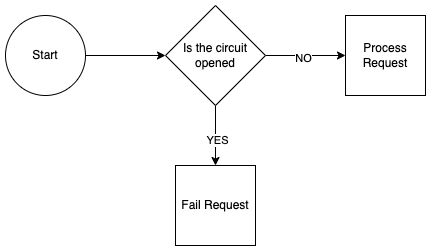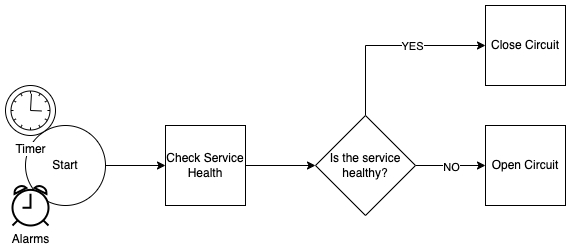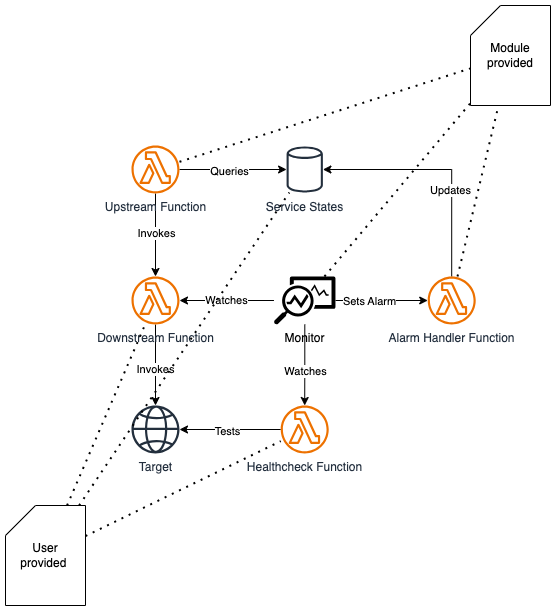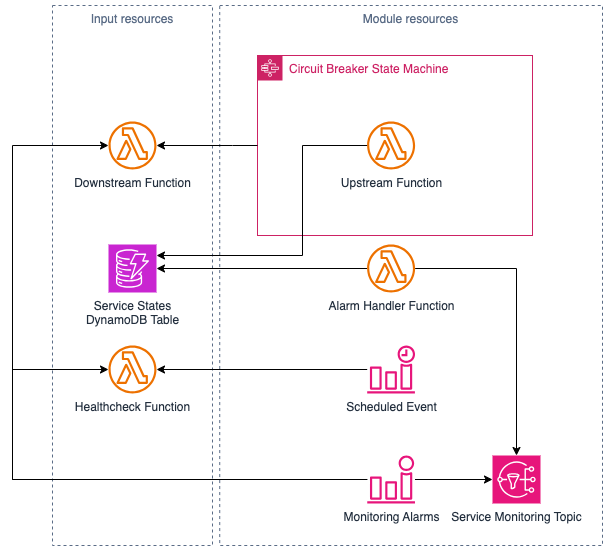Published on Tue, Dec 12, 2023 by Étienne Brouillard
Micro services are bound with challenges. Being by nature loosely coupled, they are, for example, require specific error handling patterns and the circuit breaker is one of them.
What is provided here is a usable implementation of the circuit breaker pattern using Terraform, Amazon StepFunction, AWS Lambda, Amazon DynamoDB and Amazon EventBridge.
The circuit breaker pattern is a failure isolation mechanism. During maintenance, network outages or transient downtime it might be wiser to rapidly fail instead of spending on useless cycles. A good example is payment handling on transactional websites. These often rely on external payment services and when transactions are bound to fail because of uncontrolled circumstances, it's just better for a customer to be told quickly that a payment can't be processed than leaving them in the dark for a minute. Properly applied this pattern prevents unnecessary requests and processing thus saving on time, resources, and frustration.
Simply explained, the pattern can be implemented as a state machine which checks the state of the circuit before routing to downstream service:
A key to the pattern is proper health monitoring of the aforementionned downstream service and circuit state management:
Other than the benefits of the pattern in itself, this implementation provides other tangible benefits:
- Because it is entirely serverless, scalability is not an issue. Moreover, core Lambda functions wrapped by this pattern can use any type of provisioning strategies (for concurrency and performance needs).
- Because this implementation wraps around core functions, when properly used it allows developers to focus on the business requirements rather than the plumbing. Whenever implementing patterns, look at reusability from the Infrastructure as Code point of view. Yes pattern do help on several non-functional requirements but reducing the amount of plumbing is a great way to improve implementations at little costs.
The requirements behind this module implementing the circuit breaker pattern are the following:
- Use managed and serverless services.
- Support bring your own downstream and healthcheck functions.
- Provide flexibility for alerting and monitoring.
The idea here is to wrap a service caller inside a state machine. The state machine orchestrates a sequence of steps which leads, or not, to the completion of a request. The service caller is injected into the module and it is considered the "expensive" part to protect. Provided with the service caller is a healthcheck which is triggered at pre-defined interval. This schedule trigger has the advantage that it can pre-emptively force an open or a closure of the circuit. Finally the module's implementation relies on a table to keep track of each circuit's state.
Provided by the module consumer, it is the service caller. The downstream Lambda Function is wrapped inside the state machine by the module. The downstream function must always throw when in error. This Lambda Function is monitored by Amazon Cloudwatch. Module consumer can define thresholds.
Provided with the module, it reads the circuit state from the database and returns the value to the step function. The state machine decides if it proceeds or not to the invocation of the downstream function.
Provided with the module, the alarm handler subscribes to the Service Monitoring SNS Topic and upon notification updates the circuit states DynamoDB table.
Provided by the module's consumer, this function monitors the health of the downstream function. If the downstream function becomes unhealty an error should be thrown. The healthcheck function must always throw when in error and it is monitored by Amazon Cloudwatch. Module consumer can define thresholds.
Receives Amazon Cloudwatch alarm events and forwards them to subscriptions, in this case the Alarm Handling function.
The module comes with its pre-built Lambda Functions for the upstream and circuit alarm handling. The module's consumer needs to provide:
- Downstream and Healthcheck Lambda Functions
- Circuit State management Amazon DynamoDB table
Head to the functions folder of the module and launch the build.sh script. The module uses the NodeJS 18 runtime.
The module has these key variables that require configuration:
- circuitbreakable_service_name The name of the service that is circuit breaking enabled.
- downstream_lambda_function The downstream AWS Lambda Function which is the target of the circuit breaker module.
- healthcheck_lambda_function The healthchecking AWS Lambda function.
- downstream_monitoring_configuration and healthcheck_monitoring_configuration Configures healthcheck and downstream functions monitoring settings.
- Does it support AWS Lambda Function versioning? No, not yet. I'm still trying to iron this one out...
- Is resource tagging enabled? No, it's on the wanted list.
- Estimations based on a per 100 requests.
- 2 x Lambda Invokes = 200 invocations
- 128MB RAM / 100ms per invocation (200 x 128MB/1024 x 0.1) = 2.5GBs
- 0.00001667 USD / GBs = 2.5 x 0.00001667 USD = 0.00004 USD / 100 requests.
0.00004 per 100 requests.
- Estimations based on per 100 requests.
- 0.0001 USD / 100 requests
- 128MB RAM / 200ms per invocation (100 x 128MB/1024 x 0.2) x 0.0000002083 USD = 0.000005 USD / 100 requests.
0.000045 / 100 requests.
- 1 alarm costs 0.10 USD per alarm metric: 2 x 0.10 USD = 0.20 USD per month.
- Scheduler costs 1.10 USD per million scheduled invocation: 30 x 24 x 60 / 1 000 000 x 1.10 = 0.05 USD per month.
- Scheduled healthcheck Lambda per month (128MB / 100ms): (30 x 24 x 60) x 128 / 1024 x 0.1 x 0.00001667 = 0.009 USD per month.
So all in all, it costs 0.26 USD per month and 0.000045 USD per 100 requests.






